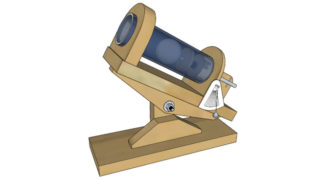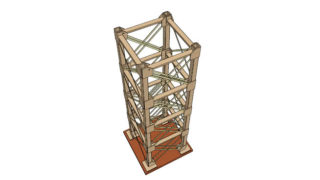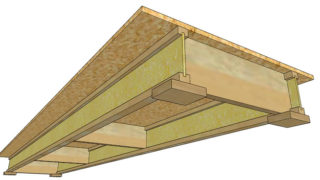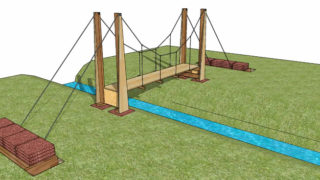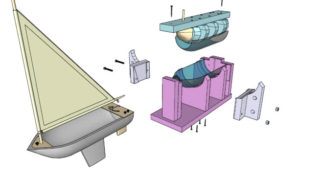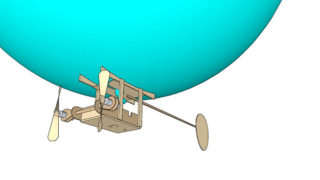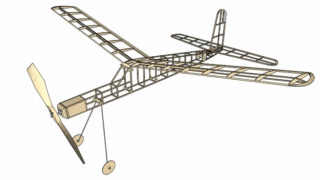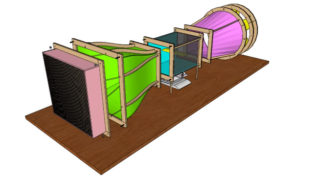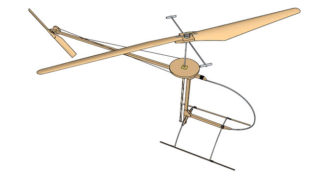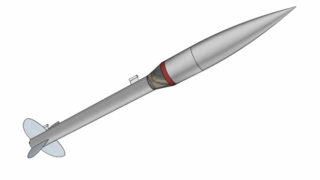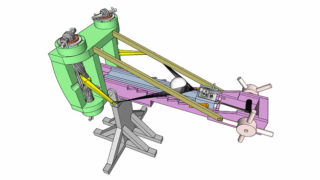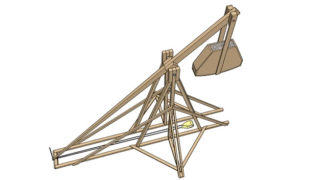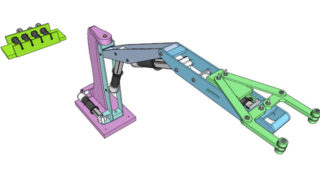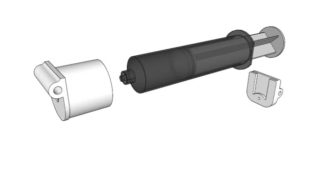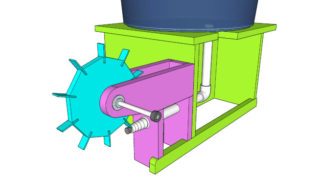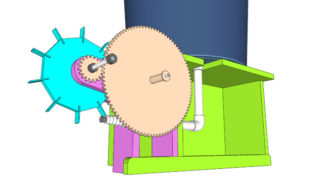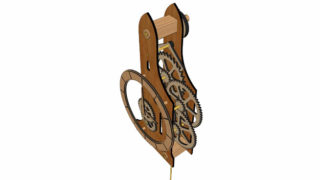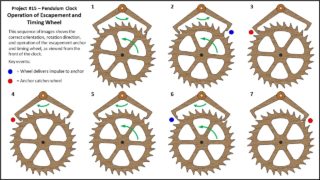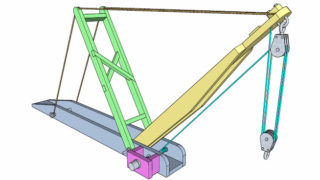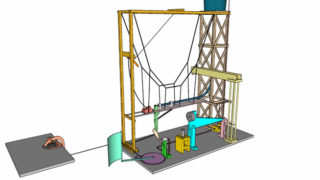DIY Engineering Resource Page
Do-It-Yourself Engineering is a unique 24-lecture video learning experience offered by The Great Courses. In this course, Steve Ressler guides you through 17 challenging hands-on projects, designed to enhance your understanding of basic math, science, and engineering concepts.
This web page provides the following supplemental DIY Engineering resources, organized by project number:
- Sketchup 3D computer models (.skp format) for all projects
- 3D computer models for 3D-printing (.dae format) for Projects 12 and 13
- Full-size layouts for laser-cutting (.eps format) for Projects 14 and 15
- Full-size layout drawings and cutting patterns (.pdf format) for Projects 1, 2, 5-9, 11-13, and 16
- Excel spreadsheets (.xlsx format) used to perform advanced computations for Projects 5, 9, and 12
PLEASE NOTE: These resources are provided solely for the use of Great Courses customers who have purchased DIY Engineering. These resources are intended as a supplement to the course, not as a substitute for it. To understand how the 17 DIY projects are designed, built, and tested, you’ll need to view the course! And by purchasing DIY Engineering, you will also be supporting the development of future courses.
If you have any questions about these resources, please check our FAQ page first. If the FAQs don’t answer your question, please contact Professor Ressler.
Project #1 (Lecture 1) – Golf Ball Launcher
Design, build, and test a mechanical device capable of launching a golf ball and hitting a target placed exactly 10 feet away from the launcher.
- Sketchup 3D model of the final design – Download from Sketchup 3D Warehouse
- Full-size cutting patterns (for printing on 8 1/2″ x 11″ paper) – Proj1-CuttingPattern.pdf (837 KB)
Project #2 (Lectures 2 & 3) – Cardboard Tower
Design, build, and test a 3-foot-tall tower with a structural system made entirely of cardboard and capable of supporting a 100-pound gravity load and a 10-pound lateral load applied at its top level.
- Sketchup 3D model of the final design – Download from Sketchup 3D Warehouse
- Full-size layout drawing (for printing on 40″ x 30″ paper) – Proj2-LayoutDrawing.pdf (371 KB)
- Full-size cutting patterns (for printing on 8 1/2″ x 11″ paper) – Proj2-CuttingPatterns.pdf (2,309 KB)
Project #3 (Lecture 4) – Beam Bridge
Design, build, and test a beam bridge with a span of 8 feet to carry pedestrians safely across a small stream.
- Sketchup 3D model of the final design – Download from Sketchup 3D Warehouse
Project #4 (Lecture 5) – Suspension Bridge
Design, build, and test a suspension bridge with a span of 8 feet to carry pedestrians safely across a small stream.
- Sketchup 3D model of the final design – Download from Sketchup 3D Warehouse
Project #5 (Lectures 6 & 7) – Concrete Sailboat
Design, build, and test a sailboat with a concrete hull, cast in a mold made from a 2-liter plastic beverage bottle.
- Sketchup 3D model of the final design, with formwork included – Download from Sketchup 3D Warehouse
- Excel spreadsheet for analyzing hull buoyancy – SailboatCalcsv2.0.xlsx (22KB)
- Full-size cutting patterns (for printing on 8 1/2″ x 11″ or 8 1/2″ x 14″ paper) – Proj5-CuttingPatterns.pdf (4,642 KB)
Project #6 (Lecture 8) – Radio-Controlled Blimp
Design, build, and test a radio-controlled electric-powered blimp, using a helium-filled latex balloon.
- Sketchup 3D model of the final design – Download from Sketchup 3D Warehouse
- Full-size cutting patterns (for printing on 8 1/2″ x 11″ paper) – Proj6-LayoutDrawing.pdf (864 KB)
Project #7 (Lectures 9, 10, & 11) – Rubber-Powered Airplane
Design, build, and test a rubber-powered free-flight model airplane.
- Sketchup 3D model of the final design – Download from Sketchup 3D Warehouse
- Full-size layout drawing (for printing on 36″ x 24″ paper) – Proj7-LayoutDrawing.pdf (977 KB)
- Full-size cutting patterns (for printing on 8 1/2″ x 11″ paper) – Proj7-CuttingPattern.pdf (912 KB)
DIY Wind Tunnel (Lectures 9 & 10)
Wind tunnel used to measure lift for various airfoil shapes in Project #7.
- Sketchup 3D model of the final design – Download from Sketchup 3D Warehouse
- Instructions, design drawings, and materials lists – WindTunnelInstructions.pdf (1,449 KB)
- Full-size templates (for printing on 48″ x 24″ paper) – WindTunnelTemplates.pdf (865 KB)
Project #8 (Lecture 12) – Rubber-Powered Helicopter
Build and test a rubber-powered free-flight model helicopter.
- Sketchup 3D model of the final design – Download from Sketchup 3D Warehouse
- Full-size layout drawing (for printing on 24″ x 16″ paper) – Proj8-LayoutDrawing.pdf (1,175 KB)
Project #9 (Lectures 13, 14, & 16) – Camera-Equipped Rocket
Design, build, and test a a model rocket capable of carrying a mini-video camera to an altitude of at least 500 feet.
- Sketchup 3D model of the final design – Download from Sketchup 3D Warehouse
- Excel spreadsheet for calculating velocity and altitude – RocketDesignCalcs2.0.xlsx (35KB)
- Full-size cutting patterns (for printing on 8 1/2″ x 11″ paper) – Proj9-CuttingPattern.pdf (846 KB)
- Full-size parachute template (for printing on 8 1/2″ x 11″ paper) – Proj9-ParachuteTemplate.pdf (813 KB)
Project #10 (Lecture 15) – Electric Launch Controller
Design, build, and test an electric launch controller to fire a model rocket igniter.
- Sketchup 3D model of the launch controller’s wooden case – Download from Sketchup 3D Warehouse
Project #11 (Lectures 17 & 18) – Ballista, Onager, and Trebuchet
Design, build, and test working models of three historically important catapults: the ballista, the onager, and the trebuchet.
- Erratum: In the Materials List for the ballista (page 213 of the course guidebook), the dimensions of the pedestal column (Component q) should be 3/4″ x 3-1/8″ x 7-11/16″.
- Sketchup 3D model of the ballista – Download from Sketchup 3D Warehouse
- Full-size cutting patterns for the ballista (for printing on 24″ x 18″ paper) – Proj11-CuttingPattern.pdf (958 KB)
- Sketchup 3D model of the onager – Download from Sketchup 3D Warehouse
- Sketchup 3D model of the trebuchet – Download from Sketchup 3D Warehouse
Project #12 (Lecture 19) – Hydraulic Arm
Design, build, and test a hydraulically powered mechanical arm capable of lifting and manipulating a 1/2-pound concrete block.
- Sketchup 3D model of the final design – Download from Sketchup 3D Warehouse
- Sketchup 3D model of syringe end caps – Download from Sketchup 3D Warehouse
- 3D models of end caps for 3D printing (.dae format) – Proj12-endcaps(dae).zip (24 KB)
- Excel spreadsheet for analyzing the arm geometry – HydraulicMachineCalcsv2.1.xlsx (54KB)
- Full-size cutting patterns (for printing on 24″ x 18″ paper) – Proj12-CuttingPattern.pdf (948 KB)
Project #13 (Lecture 20) – Water Turbine
Design, build, and test a water turbine capable of lifting a 2.2-pound weight at the turbine’s optimum power output.
- Sketchup 3D model of the final design – Download from Sketchup 3D Warehouse
- 3D model of penstock nozzle for 3D printing (.dae format) – nozzle.zip (27 KB)
- Full-size cutting patterns (for printing on 8 1/2″ x 14″ paper) – Proj13-CuttingPatterns.pdf (2,313 KB)
Project #14 (Lecture 21) – Water Turbine with Gear Train
Design, build, and test a gear train that will enable the water turbine from Project #13 to lift a 6-pound load optimally.
- Sketchup 3D model of the final design – Download from Sketchup 3D Warehouse
- Full-size layout for laser-cutting (for Ponoko only) – Proj14-GearsP2v3.zip (178 KB)
Project #15 (Lecture 22) – Wooden Pendulum Clock
Design, build, and test a wooden pendulum clock.
- Sketchup 3D model of the final design – Download from Sketchup 3D Warehouse
Full-size layout for laser-cutting (for Ponoko only) – Proj15-LaserParts(CORRECTED).zip
- Erratum: Diagram showing the correct orientation, rotation direction, and operation of the escapement anchor and timing wheel – EscapementConfig.jpg (244 KB)
Project #16 (Lecture 23) – Electric-Powered Crane
Design, build, and test an electric motor-driven crane capable of lifting 100 pounds.
- Sketchup 3D model of the final design – Download from Sketchup 3D Warehouse
- Full-size cutting patterns (for printing on 8 1/2″ x 11″ paper) – Proj16-CuttingPattern.pdf (835 KB)
Project #17 (Lecture 24) – A Tribute to Rube Goldberg
In the spirit of Rube Goldberg’s cartoons, design, build, and test a machine that will click a mouse button, while also demonstrating 20 major engineering concepts from previous “DIY Engineering” projects.
- Sketchup 3D model of the final design – Download from Sketchup 3D Warehouse
 SketchUp is a 3D modeling software package that is powerful, easy to use, and well-suited for a wide range of DIY applications. It is produced by Trimble.
SketchUp is a 3D modeling software package that is powerful, easy to use, and well-suited for a wide range of DIY applications. It is produced by Trimble.
All the projects in “DIY Engineering” were developed using SketchUp Make–a free version of Sketchup that is installed locally on a Windows or Mac computer. Shortly after “DIY Engineering” was released, Trimble discontinued Sketchup Make and replaced it with Sketchup Free, which runs in your web browser and is not locally installed. Sketchup Pro is also available for an annual subscription fee.
To view and edit the computer models provided on this page, you’ll need to use Sketchup Free or Sketchup Pro. Both are available here.
To learn how to use the software, we strongly recommend that you work through these SketchUp video tutorials.
All of our DIY Engineering models reside at the SketchUp 3D Warehouse, where they can be viewed and downloaded. To access a model in the Warehouse, just click the associated image on this page.
Questions
If you have questions about any aspect of DIY Engineering, we recommend that you first consult our FAQ page. If you can’t find the answer there, feel free to contact Professor Ressler.

